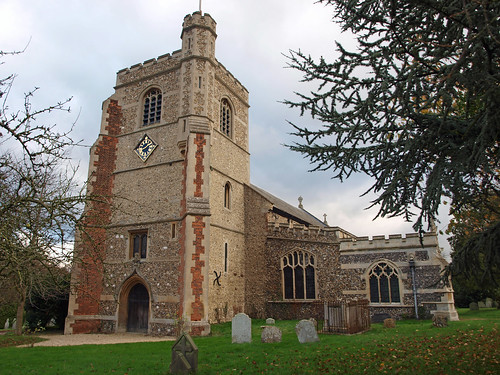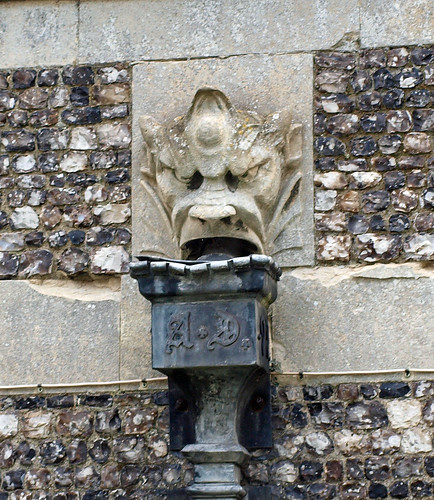St Mary and St Lawrence is indeed great, in fact it is bloody enormous! It was locked when I visited but with keyholders listed, who were both unfortunately out. I resolved to return another day and when I read Mee and subsequently Googled it, that resolve was doubled and I will update this entry upon completion.
UPDATE: I've recently, Feb 2012, been told that the church is now open daily, so having been back three or four times and always finding it locked and the keyholders elusive, a more successful visit is on the cards.
UPDATE: or so I thought; I re-visited and found it locked with no available keyholders!
UPDATE: On the off chance I re-visited last Tuesday (March 6th) and to my delight found it open. It certainly lived up to my high expectations with something for everyone.
ST MARY AND ST LAWRENCE. Quite a large church with a substantial W tower, originally Norman, but strengthened with brick buttresses; nave and aisles, and chancel. In the nave Norman quoins of Roman brick can be seen. The aisles are outside all new. The N aisle was actually built in 1875, and the S aisle was severely restored. In the chancel also traces of Norman work with Roman bricks, the rest mostly restored. The nave is remarkably wide for a Norman village church. Plain Norman tower-arch. Perp S arcade of three bays with piers having demi-shafts towards the arches and a polygonal shaft without capital towards the nave. Good nave roof of alternating tie-beam and hammer-beam trusses. The hammerbeams with figures of angels. - BENCHES. About thirty with traceried, straight-headed ends. - PLATE. Silver-gilt Paten of 1521 engraved with the head of Christ; two Cups and a Paten of 1632. - MONUMENTS. Two Brasses of 1580 and 1617. - Monument to Sir Anthony Everard, erected in 1611 (T. K. Cromwell). Standing wall-monument with stiffly reclining figures of husband and wife on two shelves - that of the husband higher and behind - between pilasters carrying stone inscription tablets. Large coffered arch above with two small arched windows in the back wall the glass of which is considered by the Royal Commission to be original. Small figures of children on small tomb-chests on the ground in front.
UPDATE: I've recently, Feb 2012, been told that the church is now open daily, so having been back three or four times and always finding it locked and the keyholders elusive, a more successful visit is on the cards.
UPDATE: or so I thought; I re-visited and found it locked with no available keyholders!
UPDATE: On the off chance I re-visited last Tuesday (March 6th) and to my delight found it open. It certainly lived up to my high expectations with something for everyone.
ST MARY AND ST LAWRENCE. Quite a large church with a substantial W tower, originally Norman, but strengthened with brick buttresses; nave and aisles, and chancel. In the nave Norman quoins of Roman brick can be seen. The aisles are outside all new. The N aisle was actually built in 1875, and the S aisle was severely restored. In the chancel also traces of Norman work with Roman bricks, the rest mostly restored. The nave is remarkably wide for a Norman village church. Plain Norman tower-arch. Perp S arcade of three bays with piers having demi-shafts towards the arches and a polygonal shaft without capital towards the nave. Good nave roof of alternating tie-beam and hammer-beam trusses. The hammerbeams with figures of angels. - BENCHES. About thirty with traceried, straight-headed ends. - PLATE. Silver-gilt Paten of 1521 engraved with the head of Christ; two Cups and a Paten of 1632. - MONUMENTS. Two Brasses of 1580 and 1617. - Monument to Sir Anthony Everard, erected in 1611 (T. K. Cromwell). Standing wall-monument with stiffly reclining figures of husband and wife on two shelves - that of the husband higher and behind - between pilasters carrying stone inscription tablets. Large coffered arch above with two small arched windows in the back wall the glass of which is considered by the Royal Commission to be original. Small figures of children on small tomb-chests on the ground in front.
GREAT WALTHAM. It has not only a treasure-house in its church but is exceptionally fortunate in the number of old houses it has kept, the Historic Monuments Commission having noted more than 80 within the bounds of the parish. A rich heritage they are from the century that saw the coming of the Tudors, from the days of Queen Elizabeth and Shakespeare, from Cromwell’s time and Charles the Second’s.
Here is an Elizabethan house with ornamental plaster on its tall chimneys and original fireplaces; here an inn from the 15th century. Only a few minutes away is a lovely house with four gables, Hyde Hall, built about 1600, still with part of its moat and a thatched barn older than itself. And just outside this delightful village is the deer park of the Langleys, a house with amazing fireplaces and over-mantels and panelled ceilings in two 17th century rooms. In its grounds is a huge chestnut tree 300 years old. Langleys was the home of the Everards, whose monuments are in the church; but since 1685 it has belonged to the Tufnells, whose memorials we also see, good friends of Essex churches for over two centuries.
Watched over by a colossal pine in the churchyard, this church would thrill any lover of the old and beautiful. The tower, nave, and chancel were built by the sons of men who came to our shores with the Conqueror and have stood more than 800 years. Roman bricks are at the corners of the walls; others were used by the Norman masons in shaping windows now blocked. But there are Norman windows still shedding their light in the tower, and a neat little doorway about as old leads to the turret stairs. The tower arch is a little younger, about 1200.
The Tudor Age gave the church its clerestory, a graceful nave arcade, a porch, and some handsome roofs. The nave roof is enriched with angels and roses and faces; and the roof added to the 14th century aisle has bosses with shields and grotesque faces. The screen is modern, but the ancient furniture is still here. Some 30 seats have been in use 500 years, carved at the ends with tracery. We see a chair of the Stuart Age with a Tudor panel, carved with a helmet in a wreath. We can open a door with rich ironwork that has been opening since the 15th century, and go through its ancient doorway to the vestry, and see panels of a Tudor pulpit. We can look at the reading desk and see some delicate woodwork from the medieval screen. On the wall is a picture of an old wall-painting that has gone, showing Christ in Majesty with the angels adoring. There is a heraldic glass from the 14th and 17th centuries.
There are brass portraits of an unknown 16th century civilian; of Thomas Wiseman, one of his two wives, and some of his children, all as they were about 1580; and of Richard Everard and his wife in Jacobean costume. The arms of other Everards are on the chancel floor; but the best thing they have left behind is the great monument Sir Anthony was erecting when death took him in 1614. On it he and his wife lie, resting on their elbows, with shields round about. On pedestals on the floor in front lie two little boys in each other’s arms and a third alone.
Little can be told of Sir Anthony’s life, but it can hardly have been more thrilling than the crowded hours of little Hugh Everard, who perished on the Goodwin Sands when he was only 16. Leaving Felstead at 13, he helped to escort King William to Holland, and two years later was lighting against Spain. He died in 1703, and his memorial has a relief of a sinking ship.
Flickr.



No comments:
Post a Comment